
 Next Meeting:
13 June at 7:30 at 9th and
Lincoln. Program: Lou Paradise expatiates about dahlia maintenance,
good grooming habits, timing blossoms, dahlia bondage and will answer
questions.
Next Meeting:
13 June at 7:30 at 9th and
Lincoln. Program: Lou Paradise expatiates about dahlia maintenance,
good grooming habits, timing blossoms, dahlia bondage and will answer
questions.
 Please bring extra tubers and dahlia plants to share with
DSC victims of attrition. Who will bring tempting snacks?
Please bring extra tubers and dahlia plants to share with
DSC victims of attrition. Who will bring tempting snacks?

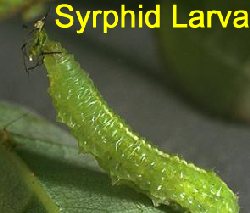 MORE
LORE: THWARTING THRIPS & PROTECTING POZIES: Kevin, serving on the American Dahlia Society’s research
committee for dahlia disease investigations, translated his extensive
experience diagnosing and treating economic crops throughout the Central
Valley into practical advice for happy home gardens. Kevin explained
that while extensive research has been conducted into viruses of cash
crops, not much has been performed on dahlias—yet! Damage control
consists of three main processes: Identification, Impact &
Intervention. Crinkled leaves? Could be virus. Holes in leaves? Could
be insects. Figure out what is causing your damage. Educate yourself
about the life cycle of the varmints involved. How bad is the impact?
If left unchecked, could it wipe you out? If it’s near show time, could
it cost you a blue or higher award? Depending upon the level of impact,
you can calculate how much artillery to bring to bear on your problem.
Using split slides to show the various life stages, Kevin delineated the
purview of several beneficial insects.
MORE
LORE: THWARTING THRIPS & PROTECTING POZIES: Kevin, serving on the American Dahlia Society’s research
committee for dahlia disease investigations, translated his extensive
experience diagnosing and treating economic crops throughout the Central
Valley into practical advice for happy home gardens. Kevin explained
that while extensive research has been conducted into viruses of cash
crops, not much has been performed on dahlias—yet! Damage control
consists of three main processes: Identification, Impact &
Intervention. Crinkled leaves? Could be virus. Holes in leaves? Could
be insects. Figure out what is causing your damage. Educate yourself
about the life cycle of the varmints involved. How bad is the impact?
If left unchecked, could it wipe you out? If it’s near show time, could
it cost you a blue or higher award? Depending upon the level of impact,
you can calculate how much artillery to bring to bear on your problem.
Using split slides to show the various life stages, Kevin delineated the
purview of several beneficial insects.
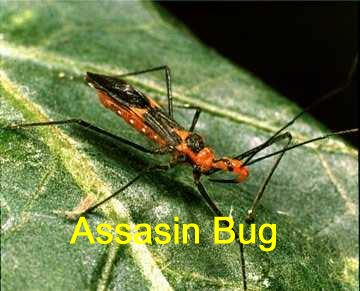
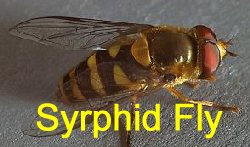
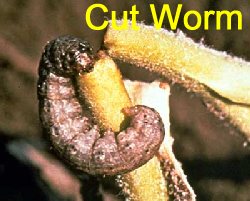 The
Syrphid fly,
minute pirate bug,
lacewings,
assassin bugs
and
ladybugs
gobble up
aphids.
Parasitic wasps
oviposit eggs into living
aphids thereby ensuring a moveable feast for their offspring. Who knew
those black and red predatory beetles were the rapacious larvae of
ladybugs? Because of our record breaking rain, Kevin predicted an epic
year for
earwigs, nasty European imports. He recommended deploying
diatomaceous earth or traps of rolled newspapers or bamboo with deadly
bait inside.
The
Syrphid fly,
minute pirate bug,
lacewings,
assassin bugs
and
ladybugs
gobble up
aphids.
Parasitic wasps
oviposit eggs into living
aphids thereby ensuring a moveable feast for their offspring. Who knew
those black and red predatory beetles were the rapacious larvae of
ladybugs? Because of our record breaking rain, Kevin predicted an epic
year for
earwigs, nasty European imports. He recommended deploying
diatomaceous earth or traps of rolled newspapers or bamboo with deadly
bait inside. 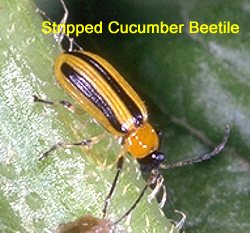
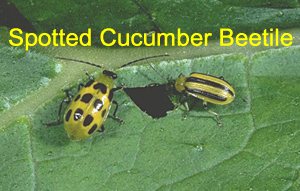
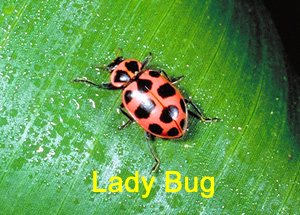 Wire worms,
cut worms and
symphylan live just below the
soil’s surface and feed at night. To detect whether you have symphylan,
leave ˝ inch slices of potatoes atop the soil. Within 48 hours they
could be covered by greedy 1/10” weeny worms. (If you slice it, they
will come?) A good soil drench like
Bayer Advanced™ All-In-One Rose & Flower Care
contains three major chemicals: insecticide, fungicide and fertilizer.
The soil drench is systemically taken up by the xylem rendering the
entire plant unpalatable to munching marauders, including
whiteflies and
thrips
which cause wrinkled, discolored leaves and
leafminers which
eat drunken paths through leaves.
Wire worms,
cut worms and
symphylan live just below the
soil’s surface and feed at night. To detect whether you have symphylan,
leave ˝ inch slices of potatoes atop the soil. Within 48 hours they
could be covered by greedy 1/10” weeny worms. (If you slice it, they
will come?) A good soil drench like
Bayer Advanced™ All-In-One Rose & Flower Care
contains three major chemicals: insecticide, fungicide and fertilizer.
The soil drench is systemically taken up by the xylem rendering the
entire plant unpalatable to munching marauders, including
whiteflies and
thrips
which cause wrinkled, discolored leaves and
leafminers which
eat drunken paths through leaves. 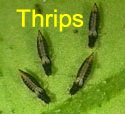
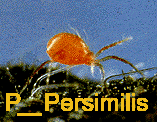 Mites thrive in hotter weather, so they plague South Bay
growers sooner than the cooler City folks. Be vigilant! Mites reproduce
fast. Besides heavy duty AVID or dusting sulfur, Kevin highly
recommended P.
Persimilis, a
predatory mite. These P. Persimilis, tend to stay in one place
(unlike wandering preying mantises) and voraciously feast on nasties.
The Monterey Bay Dahlia Society will be selling P. Persimilis at
their June meeting at bargain prices. Powdery mildew thrives in 54-77
degree weather with high humidity: exactly San Francisco conditions.
Mites thrive in hotter weather, so they plague South Bay
growers sooner than the cooler City folks. Be vigilant! Mites reproduce
fast. Besides heavy duty AVID or dusting sulfur, Kevin highly
recommended P.
Persimilis, a
predatory mite. These P. Persimilis, tend to stay in one place
(unlike wandering preying mantises) and voraciously feast on nasties.
The Monterey Bay Dahlia Society will be selling P. Persimilis at
their June meeting at bargain prices. Powdery mildew thrives in 54-77
degree weather with high humidity: exactly San Francisco conditions.

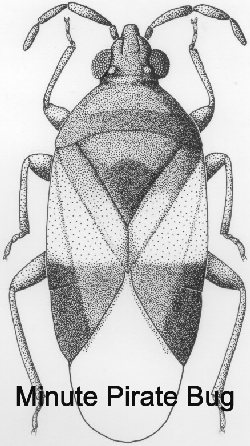
 Begin treating in June and once a month from then on with a
fungicide like
All in One,
Bayleton
or FungiFighter.
Neem oil proves a
better fungicide than insecticide. Prophylaxis—early and often—is the
best solution for mildew control.
Cucumber Beetles, the green ladybug
look-alikes, multiply in warmer weather and wreak havoc on blooms. Any
pyrethrum containing product (derived from chrysanthemums and the active
ingredient in products like RAID) works on these menaces. Since white
and yellow dahlias constitute their main draw,
yellow sticky traps prove
fatal attractions. Check
www.ipm.ucdavis.edu for pest
management guidelines. Spray either early in the morning or late in the
day for least wind. Protect yourself: don long sleeves, gloves, hat or
bandana, and toss all into the wash immediately afterwards. I strap on
a respirator that covers my nose and mouth with removable particulate
filters so I don’t inhale “cides.”
Begin treating in June and once a month from then on with a
fungicide like
All in One,
Bayleton
or FungiFighter.
Neem oil proves a
better fungicide than insecticide. Prophylaxis—early and often—is the
best solution for mildew control.
Cucumber Beetles, the green ladybug
look-alikes, multiply in warmer weather and wreak havoc on blooms. Any
pyrethrum containing product (derived from chrysanthemums and the active
ingredient in products like RAID) works on these menaces. Since white
and yellow dahlias constitute their main draw,
yellow sticky traps prove
fatal attractions. Check
www.ipm.ucdavis.edu for pest
management guidelines. Spray either early in the morning or late in the
day for least wind. Protect yourself: don long sleeves, gloves, hat or
bandana, and toss all into the wash immediately afterwards. I strap on
a respirator that covers my nose and mouth with removable particulate
filters so I don’t inhale “cides.”


WELCOME
New Officer and MEMBERS! We welcome Pat to be our new Secretary of the DSC. Looking
forward to your contributions.
Having experience growing from dahlia seeds in the past, Martha looks
forward to the rewards of cloned “pedigreed” dahlias in her future.
Christopher anticipates lots of color in his garden. Please introduce
yourselves to our new members.
VALIANT
VOLUNTEERS: Dirty thanks to Manny who helped tie all the labels
and chart up all the cultivars when Deborah planted the Dell.
Thanks to Rose for multiple times planting and watering. Thanks to
Diana for the fertilizing and ripping asunder milk cartons.
Congratulations to Tinnee and Frank for a great start on the Hillside.
Lou and the Juuls are way ahead of the rest of us. Looks like a
great season has started again! Hope to see some of you some
Saturday mornings.

 BLOOMERATI
SLUMMING? What a wonderful surprise to have the president of John E
Stowell Dahlia Society, Jeff Minor, join us. Coming down from Oregon,
we welcome Jeff, a sunstone miner. Utililizing 3 public plots in San
Leandro, Guy Chibante also checked out our DSC meeting. So glad you all
visited us.
BLOOMERATI
SLUMMING? What a wonderful surprise to have the president of John E
Stowell Dahlia Society, Jeff Minor, join us. Coming down from Oregon,
we welcome Jeff, a sunstone miner. Utililizing 3 public plots in San
Leandro, Guy Chibante also checked out our DSC meeting. So glad you all
visited us.

SHOULD
GOLDEN GATE PARK BE CLOSED ON SATURDAYS, TOO?
President
Tinnee circulated a petition against closing GG Park on Saturdays. She
cited the difficulty it would present to volunteers helping with the
dahlias, the impossibility for the handicapped to enjoy our beauties,
the loss of revenue from the Conservatory and museums, as well as the
parking pressure this would put on the neighborhoods immediately around
the park.
Ultimately Mayor Newsom listened to the people of San
Francisco who had voted against the proposal twice before and vetoed the
bill. So you can still volunteer at the Dell, still celebrate our
August picnic, and still drive in your friends to admire the official
City Flower.

 JUNE
JUBILATION: So now that you’re all planted, what’s next? If you have
tubers which have not come up after more than a month underground, it’s
time to GENTLY disinter the laggards, being mindful not to knock off any
emerging sprouts. If you discover a mushy mess, toss it out and replace
it with one of your back ups. Protect your tender lovelies against
snails, slugs and earwigs. Swash on a soil drench like Bayer’s All in
One or serve up your first cocktail of fertilizer, insecticide,
fungicide and “sticker” of liquid soap. I have spotted green aphids
already, so en garde! I have begun pinching out my centers. When you
see the first bud with its two buddies, pinch them all out down to the
next set of leaves. This puts more energy into nascent plants; as much
as we long for the first blooms of the summer, the central one would
probably be horribly crotch-bound on a negligible stem. When the next
set of buds emerge, disbud the two attendant buddettes leaving only the
central one; this will result in a bigger, stronger flower on a sturdier
longer stem. To protect my emerging “sophomores,” from my kitty, I use
wire plant hanger domes. Cut the top and bottom off half gallon milk
cartons to act as tower tubes protecting the newly planted from the
wind. Give a couple sprouted tubers to unsuspecting friends—imagine
what you could start!
JUNE
JUBILATION: So now that you’re all planted, what’s next? If you have
tubers which have not come up after more than a month underground, it’s
time to GENTLY disinter the laggards, being mindful not to knock off any
emerging sprouts. If you discover a mushy mess, toss it out and replace
it with one of your back ups. Protect your tender lovelies against
snails, slugs and earwigs. Swash on a soil drench like Bayer’s All in
One or serve up your first cocktail of fertilizer, insecticide,
fungicide and “sticker” of liquid soap. I have spotted green aphids
already, so en garde! I have begun pinching out my centers. When you
see the first bud with its two buddies, pinch them all out down to the
next set of leaves. This puts more energy into nascent plants; as much
as we long for the first blooms of the summer, the central one would
probably be horribly crotch-bound on a negligible stem. When the next
set of buds emerge, disbud the two attendant buddettes leaving only the
central one; this will result in a bigger, stronger flower on a sturdier
longer stem. To protect my emerging “sophomores,” from my kitty, I use
wire plant hanger domes. Cut the top and bottom off half gallon milk
cartons to act as tower tubes protecting the newly planted from the
wind. Give a couple sprouted tubers to unsuspecting friends—imagine
what you could start!
Looking ahead on what you might need to do in the
coming months? Check out the
Monthly Calendar.
 Dahlia Society of California, Inc., San Francisco, CA -- Copyrighted
Dahlia Society of California, Inc., San Francisco, CA -- Copyrighted
Chief Editor: Deborah Dietz
eNewsletter Editor: Ted Marr
Acknowledgement: Photos in
this issue by Deborah and Ted. Web research by Rose.

